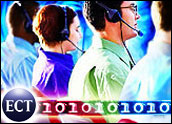
Retailers’ approach to interaction between e-commerce and the contact center is changing. The online and call center channels are starting to meld together, and perspectives on how retailers handle the two have to change.
A typical shopping experience today may go something like this: The customer browses online, fills the shopping cart, and might have a question before placing her order. The shopper then picks up the phone to call the contact center. This might look to the e-commerce manager like an abandoned session, but to the contact center, it is viewed as a brand new phone opportunity. In the ideal scenario, the e-commerce and contact center channels are linked and work together to pass on opportunities.
In the example, if the contact center agent knew the customers’ previous interaction on the Web, she could act like a store clerk: look in the shopping cart, answer questions based on the current order and make suggestions. Creating this type of integrated, collaborative shopping experience is difficult but when it is done well, it is highly rewarding and eliminates customer frustration.
Consistent Shopping Experience Across Channels
Whether consumers do business on the phone or online, they expect the same seamless shopping experience. Merchants must take a number of complex circumstances into consideration when servicing customers — setting the right pricing and promotions rules, providing pick-up and delivery options, creating cross-sell and up-sell opportunities, and how each contact center agent interacts with each shopper. The goal is to make sure each of these complicated tasks work together to create consistency of information across channels and help to boost sales in real time.
When the contact center becomes an extension of the e-commerce channel, contact center agents will be able to access promotions and pricing rules that are delivered by the online channel. If these rules are readily accessible to the contact center agent, she in turn can use them to convert successful sales transactions. As a result, the ultimate goal in retail — converting current and new customers into return shoppers — becomes attainable.
E-Commerce Data Empowers Agents
Because the e-commerce channel offers a rich set of merchandising and marketing information, it is the natural choice to be a feeder channel into the contact center. Call center agents must have the same depth of content customers are getting online, and be able to answer customers’ questions intelligently.
The Web and contact center of the future need to go even one step further and create a real-time information and communication exchange so the contact center agent becomes proactive rather than reactive. New technology applications can arm agents with this information to convert more sales using product-specific and transaction-specific information. With a view into the customers’ online activities, agents also can do a better job of cross-selling and up-selling.
The best next-generation e-commerce applications will not only offer product and promotion information targeted specifically to the shopper on the phone, but also provide product ratings and reviews. The customer experience is heightened when contact center agents are able to share product review information during the call, and the agent increases her chance of converting an even bigger sale.
Varied Promotions Help Close the Sale
Part of the beauty of using the e-commerce channel as the feeder for the contact center is that promotions, marketing rules and product recommendations can be fed directly from the merchant to the call center. The agent then knows immediately if a customer is searching for a specific product and if there is a promotion tagged specifically to that item. These preprogrammed rules create millions of promotion possibilities.
Without targeted and varied promotions, call center agents are stuck only being able to offer a few generic promotions that might not meet the specific needs of the shopper on the phone. They have no additional information other than what’s already available to the customer on the Web site, and often find themselves almost competing with the customer to access the product information on the Web site first, so they can appear to be helpful. Savvy shoppers today will not stand for this type of lackluster customer service.
Outsourcing Becomes Personal
While outsourcing the contact center in the past has sometimes translated to a lower quality experience for shoppers, it doesn’t have to — as long as the agents are empowered with information to make their interactions effective, efficient and profitable. Retailers must be aware, however, that because more contact centers are being staffed with a transient, geographically diverse workforce (for example work-at-home moms), quality control can becomes an issue.
Although hiring at-home workers is a financially and logistically efficient staffing model, it presents challenges in maintaining the quality of customer interactions. Merchants can solve this dilemma by using technology to extend the content, promotions and data from the e-commerce channel to these agents, and the business can reap the benefits of the distributed staffing model.
Single Interface Customizes Product Presentation
Simplicity is key when dealing with a transient workforce. By using a single user interface (UI), the entire set of rich e-commerce merchandising data can easily be accessed by the contact center application. For retailers who want to customize their applications, the best systems will offer a number of application programming interfaces (API).
Retailers must be able to take a new agent and make her productive as quickly as possible. Using the single UI setup, the contact center agent can convert more customers and work faster. As a result, contact center managers can focus on teaching agents’ professionalism rather than focusing on getting them up to speed on product knowledge.
Connected Call Center Unlocks Hidden Revenue
Retail is all about cross-selling and up-selling and empowering all retail employees, including call center agents. Connecting the call center to the Web allows retailers to feed product and promotion rules to agents, putting them in control of the customer experience. Sophisticated retailers that achieve a truly integrated Web and call center will gain a competitive edge and enjoy additional revenue that can make or break a business — and especially in today’s down economy — every little bit counts.
Stephan Schambach is founder and chairman at Demandware, an enterprise-class on-demand e-commerce platform vendor.












































